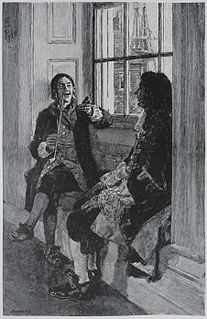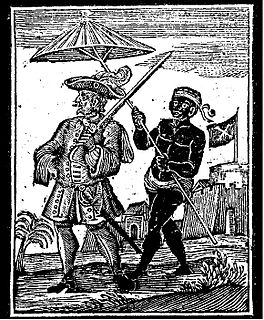Related Research Articles

Haematoxylum campechianum is a species of flowering tree in the legume family, Fabaceae, that is native to southern Mexico, and introduced to the Caribbean, northern Central America, and other localities around the world. The tree was of great economic importance from the 17th century to the 19th century, when it was commonly logged and exported to Europe for use in dyeing fabrics. The modern nation of Belize developed from 17th- and 18th-century logging camps established by the English. The tree's scientific name means "bloodwood".

Thomas Tew, also known as the Rhode Island Pirate, was a 17th-century English privateer-turned-pirate. He embarked on two major pirate voyages and met a bloody death on the second, and he pioneered the route which became known as the Pirate Round. Many other infamous pirates followed in his path, including Henry Every and William Kidd.

Stede Bonnet was an early 18th-century Barbadian pirate, sometimes called "The Gentleman Pirate" because he was a moderately wealthy land-owner before turning to a life of crime. Bonnet was born into a wealthy English family on the island of Barbados, and inherited the family estate after his father's death in 1694. On November 21, 1709, twenty-one-year-old Stede Bonnet married sixteen-year-old Mary Allamby.
John Taylor was a pirate active in the Indian Ocean, best known for participating in two of the richest pirate captures of all time.

Henry Every, also known as Henry Avery, sometimes erroneously given as Jack Avery or John Avery, was an English pirate who operated in the Atlantic and Indian oceans in the mid-1690s. He probably used several aliases throughout his career, including Benjamin Bridgeman, and was known as Long Ben to his crewmen and associates.
Edward Coates was a colonial American privateer in English service during King William's War and later a pirate operating in the Red Sea and Indian Ocean.
Adam Baldridge was an English pirate and one of the early founders of the pirate settlements in Madagascar.
The Pirate Round was a sailing route followed by certain, mainly English, pirates, during the late 17th century and early 18th century. The course led from the western Atlantic, parallel to the Cape Route around the southern tip of Africa, stopping at Madagascar, then on to targets such as the coast of Yemen and India. The Pirate Round was briefly used again during the early 1720s. Pirates who followed the route are sometimes referred to as Roundsmen. The Pirate Round was largely co-extensive with the routes of the East India Company ships, of Britain and other nations.
Thomas Wake was a pirate from Newport. Active during the Golden Age of Piracy, he is best known for sailing alongside Thomas Tew to join Henry Every in the Indian Ocean, hunting the Moghul treasure fleet.
John Ireland was a pirate active in the Indian Ocean. He is best known for sailing with Thomas Tew.
Richard Want was a pirate active in the Indian Ocean. He is best known for sailing alongside Thomas Tew and Henry Avery.
John Hoar was a pirate and privateer active in the late 1690s in the Red Sea area.
Robert Glover was an Irish-American pirate active in the Red Sea and Indian Ocean area in the late 1690s.
Richard Glover was a pirate and slave-trader active in the Caribbean and the Red Sea in the late 1690s.
Richard Bobbington was a pirate active in the Red Sea, Indian Ocean, and Persian Gulf in the late 1690s.
Thomas Mostyn was a sea captain and slave trader active between New York and the Indian Ocean, and later in the Caribbean. He was one of the traders employed by New York merchant Frederick Philipse to smuggle supplies to the pirates of Madagascar.
Josiah Raynor (1665–1743) was a pirate active in the Red Sea. Before he was briefly a pirate captain, he was a sailor on the Batchelor’s Delight on which he sailed alongside William Dampier.
Thomas Larimore was a privateer and pirate active in the Caribbean and off the eastern seaboard of the American colonies. After helping suppress Bacon’s Rebellion and serving as a militia leader he turned to piracy, his activities intertwined with those of fellow pirate John Quelch.
Paulsgrave Williams, first name occasionally Paul, Palsgrave, or Palgrave, was a pirate who was active 1716–1723 and sailed in the Caribbean, American eastern seaboard, and off West Africa. He is best known for sailing alongside Samuel Bellamy.
HMS Revenge (1741) was a privateering vessel commissioned by Governor of Rhode Island, Richard Ward in 1741. In his Letter of Marque, Ward names Benjamin Norton as captain, commanding him to commandeer any Spanish ship he may come across. Throughout the sloop's five month cruise, Norton kept a detailed journal of the ship's daily encounters. The ship was set to sail down the East Coast of the colonies to the Caribbean, and stop any Spanish ships from delivering supplies, or taking supplies.
References
- ↑ See Jameson, pages 147-151 (depositions from Tay and others) and pages 180-187 (deposition of Adam Baldridge).
- 1 2 3 4 5 6 7 Jameson, John Franklin (1923). Privateering and Piracy in the Colonial Period. New York: Macmillan. Retrieved 24 June 2017.
- ↑ Proceedings of the Massachusetts Historical Society. Boston: The Society. 1873. p. 116. Retrieved 25 June 2017.
- ↑ Randolph, Edward (1899). Edward Randolph: Including His Letters and Official Papers for the New England, Middle, and Southern Colonies in America, with Others Documents Relating Chiefly to the Vacating of the Royal Charter of the Colony of Massachusetts Bay, 1676-1703. Boston: Prince Society. p. 44. Retrieved 25 June 2017.
- ↑ "The Pirate Surgeon's Journal: Golden Age of Piracy History of Pirate Surgeons Page 9". www.piratesurgeon.com. Retrieved 25 June 2017.
- ↑ Appleby, John C. (2015). Women and English Piracy, 1540-1720: Partners and Victims of Crime. Woodbridge: Boydell & Brewer Ltd. p. 34. ISBN 9781783270187 . Retrieved 25 June 2017.
